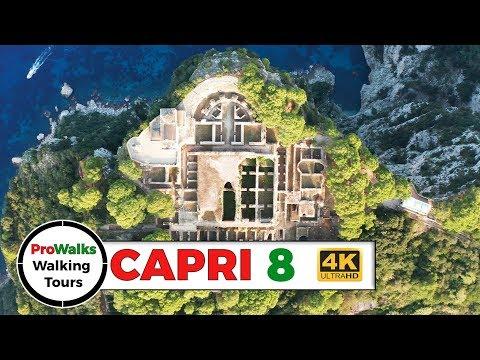The sun was beginning its descent over the Tyrrhenian Sea as I walked up the steep path that led to Villa Jovis. The golden light played across the rugged terrain of Capri, casting long shadows and highlighting the ancient stone that had borne witness to centuries of history. I had always been fascinated by the tales of emperors and their opulent residences, but Villa Jovis held a special allure for me. The stories whispered of its grandeur and its isolation, creating an aura of mystique that was simply irresistible.
My footsteps echoed softly as I climbed, my mind drifting back to the days when the villa was at its zenith. Emperor Tiberius, known for his enigmatic and often cruel reign, had chosen this very spot as his retreat from the prying eyes of Rome. It was said that from this vantage point, he could gaze out over the endless expanse of the sea and maintain an almost god-like distance from the chaos of his empire. The contrast between the serene setting and the turbulent history that surrounded Tiberius was striking, and I couldn’t help but feel a sense of awe as I approached the site.
The first glimpse of the villa, framed by the jagged cliffs and lush greenery, was breathtaking. The structure seemed to merge with the mountain, as if it had grown out of the very rock itself. The remnants of the once-grand palace were still impressive. The imposing walls and the remnants of elaborate mosaics spoke of a time when luxury and power were paramount. As I walked through the arched entrance, I imagined the grandeur of the villa during Tiberius’ reign—lavish feasts, intricate ceremonies, and the murmur of courtiers in the vast halls.
Inside, the villa was a labyrinth of rooms and corridors. The ancient stone floors were worn smooth from centuries of footsteps. I wandered through the ruins, my footsteps mingling with the echoes of history. The palace’s layout was both intricate and purposeful, with a network of rooms and terraces designed to take full advantage of the stunning vistas. From the central courtyard, I could see how the villa was organized, with various wings extending outward, each offering its own view of the surrounding landscape.
One of the most striking features of Villa Jovis was its extensive system of terraces. They seemed to cascade down the hillside, providing a series of breathtaking vantage points. Standing on one of these terraces, I felt as if I were suspended between earth and sky. The panoramic view of the sea was mesmerizing, and I could understand why Tiberius had chosen this spot as his sanctuary. The isolation of the villa was both a blessing and a curse—offering tranquility but also separating him from the world he ruled.
As I explored further, I came across the remnants of what must have been luxurious living quarters. The walls were adorned with faded frescoes, their colors muted but still evocative of the opulence that once characterized the villa. The intricate designs hinted at the splendor that had been, and I could almost hear the laughter and music that might have filled these rooms. The villa’s grandeur was undeniable, even in its ruins.
One particular area of the villa captured my imagination—the so-called “Temple of Jupiter.” Though only the foundation remained, it was clear that this was once a place of great significance. The name itself hinted at the religious and political importance of the site. Tiberius was known for his religious piety, and it was fascinating to consider how this temple might have played a role in his life and reign. I could almost picture him standing here, performing rituals and invoking the favor of the gods as he looked out over his domain.
The sense of isolation at Villa Jovis was palpable. Despite its grand scale, the villa felt remote and disconnected from the world. It was easy to imagine how Tiberius might have felt both liberated and imprisoned by this solitude. The silence was profound, broken only by the occasional rustle of leaves or the distant cry of a seabird. It was a silence that spoke of both peace and foreboding—a fitting backdrop for a ruler whose life had been marked by both power and paranoia.
As the sun dipped below the horizon, I reluctantly made my way back down the path. The shadows grew longer, and the villa seemed to merge with the twilight, becoming a part of the mountain’s silhouette. I reflected on the stories and legends that had drawn me to this place and the sense of connection I felt to the distant past. Villa Jovis was more than just a ruin; it was a window into a world that had once been vibrant and full of life.
The journey to Villa Jovis had been a pilgrimage of sorts, a quest to understand the intersection of history and mythology. As I descended the path, the first stars began to twinkle in the night sky, and I felt a profound sense of gratitude for the opportunity to walk among the remnants of a bygone era. Villa Jovis had given me a glimpse into the life of one of history’s most enigmatic figures, and that glimpse would stay with me long after I had left Capri behind.
